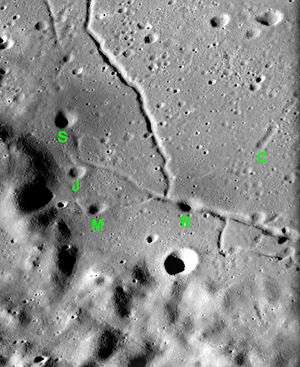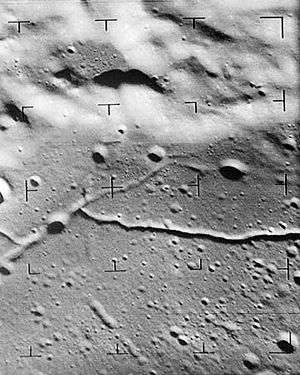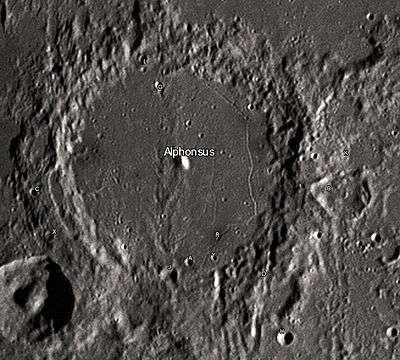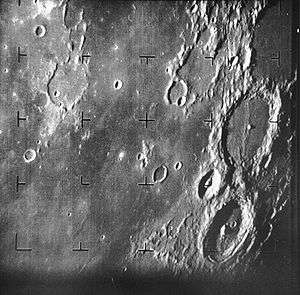Alphonsus (crater)
_1.png) LRO image | |
| Coordinates | 13°24′S 2°48′W / 13.4°S 2.8°WCoordinates: 13°24′S 2°48′W / 13.4°S 2.8°W |
|---|---|
| Diameter | 119 km |
| Depth | 2.7 km |
| Colongitude | 4° at sunrise |
| Eponym | Alfonso X |
Alphonsus is an ancient impact crater on the Moon that dates from the pre-Nectarian era.[1] It is located on the lunar highlands on the eastern end of Mare Nubium, west of the Imbrian Highlands, and slightly overlaps the crater Ptolemaeus to the north. To the southwest is the smaller Alpetragius and further south is the slightly smaller Arzachel. Together with Ptolemaeus and Arzachel, the crater form a prominent line of craters.
Description
The surface of Alphonsus is broken and irregular along its boundary with Ptolemaeus. The outer walls are slightly distorted and possess a somewhat hexagonal form.
A low ridge system of deposited ejecta bisects the crater floor, and includes the steep central peak designated Alphonsus Alpha (α). This pyramid-shaped formation rises to a height of 1.5 km above the interior surface. It is not volcanic in origin, but rather is made of anorthosite like the lunar highlands.
The floor is fractured by an elaborate system of rilles and contains three smaller craters surrounded by a symmetric darker halo. These dark-halo craters are cinder cone-shaped and are believed by some to be volcanic in origin, although others think they were caused by impacts that excavated darker mare material from underneath the lighter lunar regolith.
Exploration
The Ranger 9 probe impacted in Alphonsus, a short distance to the northeast of the central peak. Harold Urey said of a close-up photograph of Alphonsus:
| “ | The floor is covered with many craters of various sizes, some sharp and hence new, others less distinct and partly filled with fragmented material. The walls have fewer craters, and this probably means that slumping of the wall has filled them. Crevasses are evident, and evidence for slumping exists. The larger crater near the top is undoubtedly collisional in origin. Three craters are surrounded by dark halos and were produced by eruptions from the lunar interior. Exceptionally bright, sharp peaks can be seen on certain mountain tops.[2] | ” |
Alphonsus was one of the primary alternative landing sites considered for both the Apollo 16 and the Apollo 17 missions.
Transient lunar phenomena
Alphonsus is one of the sites noted for transient lunar phenomena, as glowing red-hued clouds have been reported emanating from the crater. On October 26, 1956, the lunar astronomer Dinsmore Alter noted some blurring of the rilles on the floor of Alphonsus in the photographs he took in violet light. The same blurring did not occur in the infrared photographs he took at the same time. However, few professional astronomers found this evidence of volcanic activity on the Moon very convincing.[3]
One astronomer who was intrigued by Alter's observations was Nikolai A. Kozyrev, from the Soviet Union. In 1958 while Kozyrev was looking for volcanic phenomenon on the moon, he observed the formation of a mist-like cloud within Alphonsus.[4] The spectrum of the area had been measured at this time, and displayed indications of carbon matter, possibly C2 gas. He believed this to be the result of volcanic or related activity. However no evidence for this phenomenon has been found from lunar missions, and the emission results have never been confirmed.[5]
Names
Alphonsus is named after King Alfonso X of Castile (known as "Alfonso the Wise"), who had an interest in astronomy. Like many of the craters on the Moon's near side, it was given its name by Giovanni Riccioli, whose 1651 nomenclature system has become standardized; Riccioli originally named it "Alphonsus Rex" ('King Alfonso'), but the 'Rex' was later dropped.[6] Earlier lunar cartographers had given the feature different names. Michael van Langren's 1645 map calls it "Ludovici XIV, Reg. Fran.", after Louis XIV of France,[7] and Johannes Hevelius called it "Mons Masicytus" after a range of mountains in Lycia.[8]
Interior craters


Five tiny craters in the northeastern part of Alphonsus' interior floor have been assigned names by the IAU. These are listed in the table below.
| Crater | Coordinates | Diameter | Name source |
|---|---|---|---|
| Chang-Ngo | 12°42′S 2°06′W / 12.7°S 2.1°W | 3 km | Chinese goddess of the moon |
| José | 12°42′S 1°36′W / 12.7°S 1.6°W | 2 km | Spanish masculine name |
| Monira | 12°36′S 1°42′W / 12.6°S 1.7°W | 2 km | Arabic feminine name |
| Ravi | 12°30′S 1°54′W / 12.5°S 1.9°W | 2.5 km | Indian masculine name |
| Soraya | 12°54′S 1°36′W / 12.9°S 1.6°W | 2 km | Persian feminine name |
Satellite craters

By convention these features are identified on lunar maps by placing the letter on the side of the crater midpoint that is closest to Alphonsus.
| Alphonsus | Latitude | Longitude | Diameter |
|---|---|---|---|
| A | 14.8° S | 2.3° W | 4 km |
| B | 13.2° S | 0.2° W | 24 km |
| C | 14.4° S | 4.8° W | 4 km |
| D | 15.1° S | 0.8° W | 23 km |
| G | 12.3° S | 3.3° W | 4 km |
| H | 15.6° S | 0.5° W | 8 km |
| J | 15.1° S | 2.5° W | 8 km |
| K | 12.5° S | 0.1° W | 20 km |
| L | 12.0° S | 3.7° W | 4 km |
| R | 14.4° S | 1.9° W | 3 km |
| X | 15.0° S | 4.4° W | 5 km |
| Y | 14.7° S | 1.8° W | 3 km |
Notes
- ↑ Ambrose, W.A. "ORIGIN, DISTRIBUTION, AND CHRONOSTRATIGRAPHY OF ASYMMETRIC SECONDARY CRATERS ASSOCIATED WITH NEARSIDE LUNAR BASINS" (PDF). Bureau of Economic Geology. University of Texas at Austin, TX. Retrieved 25 September 2013.
- ↑ EXPLORING SPACE WITH A CAMERA, Section 2, To The Moon and Beyond, NASA Special Pulication 168 (SP-168)
- ↑ Dinsmore (1957), 69: 158
- ↑ Oepik, E.J. "Cratering and the moon's surface". Armagh Observatory. Department of Physics and Astronomy, University of Maryland. Retrieved 20 September 2011.
- ↑ Dinsmore (1957), 71: 46
- ↑ Ewen A. Whitaker, Mapping and Naming the Moon (Cambridge University Press, 1999), p.210.
- ↑ Ewen A. Whitaker, Mapping and Naming the Moon (Cambridge University Press, 1999), p. 198.
- ↑ Ewen A. Whitaker, Mapping and Naming the Moon (Cambridge University Press, 1999), p. 205.
References
- Andersson, L. E.; Whitaker, E. A. (1982). NASA Catalogue of Lunar Nomenclature. NASA RP-1097.
- Blue, Jennifer (July 25, 2007). "Gazetteer of Planetary Nomenclature". USGS. Retrieved 2007-08-05.
- Bussey, B.; Spudis, P. (2004). The Clementine Atlas of the Moon. New York: Cambridge University Press. ISBN 978-0-521-81528-4.
- Cocks, Elijah E.; Cocks, Josiah C. (1995). Who's Who on the Moon: A Biographical Dictionary of Lunar Nomenclature. Tudor Publishers. ISBN 978-0-936389-27-1.
- McDowell, Jonathan (July 15, 2007). "Lunar Nomenclature". Jonathan's Space Report. Retrieved 2007-10-24.
- Menzel, D. H.; Minnaert, M.; Levin, B.; Dollfus, A.; Bell, B. (1971). "Report on Lunar Nomenclature by the Working Group of Commission 17 of the IAU". Space Science Reviews. 12 (2): 136–186. Bibcode:1971SSRv...12..136M. doi:10.1007/BF00171763.
- Moore, Patrick (2001). On the Moon. Sterling Publishing Co. ISBN 978-0-304-35469-6.
- Price, Fred W. (1988). The Moon Observer's Handbook. Cambridge University Press. ISBN 978-0-521-33500-3.
- Rükl, Antonín (1990). Atlas of the Moon. Kalmbach Books. ISBN 978-0-913135-17-4.
- Webb, Rev. T. W. (1962). Celestial Objects for Common Telescopes (6th revised ed.). Dover. ISBN 978-0-486-20917-3.
- Whitaker, Ewen A. (1999). Mapping and Naming the Moon. Cambridge University Press. ISBN 978-0-521-62248-6.
- Wlasuk, Peter T. (2000). Observing the Moon. Springer. ISBN 978-1-85233-193-1.
Further reading
- Wood, Chuck (2005-04-06). "Micro-Topo". Lunar Photo of the Day. Archived from the original on 2006-05-14. Retrieved 2006-07-21.
- Cortright, Edgar M. (1968). "Rangers Bring the Moon Up Close". SP-168 Exploring Space with a Camera. NASA Langley Research Center. p. 48.
- Alter, Dinsmore (1957). "A Suspected Partial Obscuration of the Floor of Alphonsus". Publications of the Astronomical Society of the Pacific. 69: 158. Bibcode:1957PASP...69..158A. doi:10.1086/127036.
- Alter, Dinsmore (1959). "The Kozyrev Observations of Alphonsus". Publications of the Astronomical Society of the Pacific. 71: 46. Bibcode:1959PASP...71...46A. doi:10.1086/127330.
- Compton, W. David (1989). "Where No Man Has Gone Before: A History of Apollo Lunar Exploration Missions". NASA. Retrieved 2007-02-09.
External links
| Wikimedia Commons has media related to Alphonsus (crater). |
- Alphonsus at The Moon Wiki
- Rimae Alphonsus at The Moon Wiki
- Alphonsus crater mantled floor fracture, from LROC
- Lunar Orbiter map and photo of Alphonsus
Other related articles
- Wood, Chuck (May 15, 2004). "The Golden Triad". Lunar Photo of the Day.
- Wood, Chuck (May 21, 2004). "Volcanic Craters on the Moon". Lunar Photo of the Day.
- Wood, Chuck (October 31, 2004). "Sunrise and Sunset on the Triade". Lunar Photo of the Day. - one of three craters making up a Triad which includes Alphonsus
- Wood, Chuck (July 10, 2006). "Craters and Papers". Lunar Photo of the Day. Archived from the original on September 16, 2017.
- Wood, Chuck (September 16, 2006). "Just Another Glorious Image". Lunar Photo of the Day. Archived from the original on September 16, 2017.
- Wood, Chuck (November 27, 2006). "A Long Line in the Matter of Confidence". Lunar Photo of the Day. Archived from the original on September 16, 2017.
- NASA Astronomy Picture of the Day: Ptolemaeus, Alphonsus and Arzachel (9 February 2007)
- Wood, Chuck (February 13, 2007). "New Observations of a Well-Known Area". Lunar Photo of the Day. Archived from the original on September 16, 2017.

